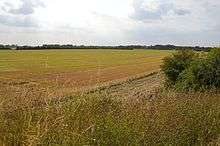Whittlesford - Thriplow Hummocky Fields
Whittlesford - Thriplow Hummocky Fields is a 55.6 hectare biological Site of Special Scientific Interest between Whittlesford and Thriplow in Cambridgeshire.[1][2] This site has two unusual species, the nationally rare grass-poly, which is only found in south Cambridgeshire on the British mainland, and the nationally uncommon fairy shrimp Chirocephalus diaphanus. They are found in shallow hollows in arable fields, which are the result of ice lenses melting at the end of the last ice age. There are also uncommon liverworts.[1]
| Site of Special Scientific Interest | |
 | |
| Area of Search | Cambridgeshire |
|---|---|
| Grid reference | TL 447 484 |
| Interest | Biological |
| Area | 55.6 hectares |
| Notification | 1987 |
| Location map | Magic Map |
The site
This site consists of two fields, one at Whittlesford and one at Thriplow with a total area of 55.6 ha (137.4 acres). This region was affected by the most recent ice age, and it left behind depressions which resulted from the melting of ice lenses, where the freezing of water-saturated soil causes deformation and the upward thrust of the ground surface. These depressions provide suitable habitat for grass-poly (Lythrum hyssopifolia), a very rare plant in Great Britain. Other plants growing in this specialised habitat include toad rush (Juncus bufonius), greater plantain (Plantago major), knotgrass (Polygonum aviculare), redshank (Persicaria maculosa) and the very local tasteless water-pepper (Persicaria mitis). There are also some uncommon liverworts at the site; Riccia cavernosa, Riccia warnstorfii and Riccia subbifurca. There is a requirement for both flooding and ploughing of the site to maintain this specialised community and provide suitable conditions for it to continue.[1]
Another rarity found at this site is the fairy shrimp (Chirocephalus diaphanus),[1] here at the most northerly end of its range, a crustacean, protected under the Wildlife and Countryside Act 1981.[3] Its eggs can survive dessication and hatch when the depressions fill with water.[1]
References
- "Whittlesford - Thriplow Hummocky Fields citation" (PDF). Sites of Special Scientific Interest. Natural England. Retrieved 22 March 2020.
- "Map of Whittlesford - Thriplow Hummocky Fields". Sites of Special Scientific Interest. Natural England. Retrieved 22 March 2020.
- "Fairy shrimp (Chirocephalus diaphanus)". ARKive. Archived from the original on 30 June 2010. Retrieved 10 September 2010.
| Wikimedia Commons has media related to Whittlesford-Thriplow Hummocky Fields. |